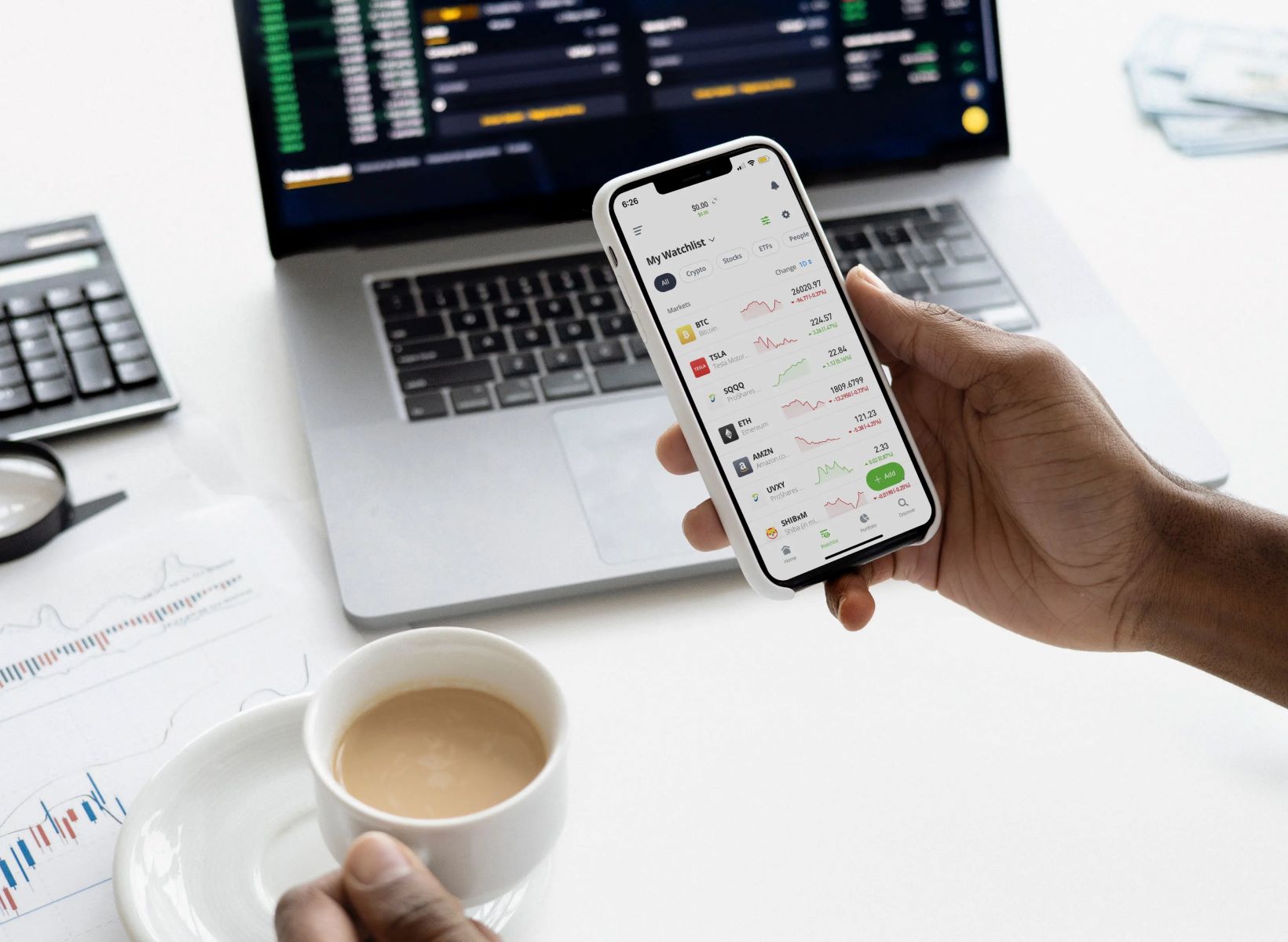

Finance
How To Create An Investment Platform
Modified: December 30, 2023
Learn how to create a powerful investment platform and enhance your financial prospects with our comprehensive finance guide. Start investing wisely and securing your future today!
(Many of the links in this article redirect to a specific reviewed product. Your purchase of these products through affiliate links helps to generate commission for LiveWell, at no extra cost. Learn more)
Table of Contents
- Introduction
- Step 1: Define the Purpose of the Investment Platform
- Step 2: Research Different Investment Options
- Step 3: Choose the Right Technology Platform
- Step 4: Design and Develop the Investment Platform
- Step 5: Set up Security Measures
- Step 6: Integrate Payment Systems
- Step 7: Test and Launch the Investment Platform
- Step 8: Market and Promote the Investment Platform
- Step 9: Monitor and Optimize the Platform’s Performance
- Conclusion
Introduction
Welcome to the world of investment platforms, where technology meets finance to bring the benefits of investment opportunities to a wider audience. In today’s digital age, creating an investment platform has become more accessible than ever before. Whether you’re an entrepreneur looking to start your own investment business or a financial institution seeking to expand your offerings, building an investment platform can be a lucrative venture.
An investment platform provides individuals with access to a wide range of investment opportunities, allowing them to diversify their portfolios and potentially earn higher returns. It acts as a bridge between investors and investment products, enabling individuals to invest in various asset classes such as stocks, bonds, real estate, and even alternative investments like cryptocurrency.
Creating an investment platform requires careful planning, research, and execution. It involves a combination of financial knowledge, technological expertise, and a user-centric approach. By following a step-by-step process, you can create a robust and user-friendly investment platform that meets the needs and preferences of your target audience.
In this article, we will guide you through the essential steps involved in creating an investment platform. From defining the purpose of your platform to marketing and promoting it, we will cover all the crucial aspects needed to build a successful investment platform. So, let’s dive in and explore the steps required to create your own investment platform.
Step 1: Define the Purpose of the Investment Platform
Before embarking on the journey of creating an investment platform, it’s essential to clearly define its purpose. Understanding the why behind your platform will set the foundation for your entire project.
Ask yourself: What problem does my investment platform aim to solve? Are you targeting novice investors who need guidance and education, or are you catering to experienced investors who seek advanced investment options? Determining your target audience and their specific needs is crucial in shaping the features and functionalities of your platform.
Consider the types of investments you want to offer. Will your platform focus on traditional assets like stocks and bonds, or do you want to incorporate alternative investments like real estate or peer-to-peer lending? Defining the types of investment options available will guide your research and development process.
Furthermore, think about the level of automation and customization you want to provide. Are you aiming for a self-service platform where users can manage their investments independently, or do you want to offer personalized investment advice and portfolio management services? Clearly outlining these aspects will help you tailor the investment platform to cater to your target audience’s preferences.
Another important consideration is the geographic scope of your platform. Will it be targeted towards a specific country or region, or do you plan to offer global investment opportunities? Understanding the market you intend to serve will influence various factors, such as regulatory compliance, localization, and language support.
Lastly, think about your monetization strategy. How will you generate revenue from your investment platform? Common revenue models include charging fees on transactions, subscription plans, or receiving commissions from fund providers. Aligning your monetization strategy with your target audience’s expectations and market norms is crucial for long-term sustainability and profitability.
Defining the purpose of your investment platform is the first step towards creating a focused and successful platform. It sets the direction for all subsequent decisions and actions, guiding you through the entire development process.
Step 2: Research Different Investment Options
Once you have a clear understanding of the purpose and target audience of your investment platform, it’s time to embark on thorough research of the different investment options you can offer. This step is crucial as it directly impacts the investment opportunities available to your users and determines the diversification potential of your platform.
Start by exploring traditional investment options such as stocks, bonds, mutual funds, and exchange-traded funds (ETFs). Understand the characteristics, risks, and potential returns associated with each asset class. This will help you determine which ones align with your platform’s purpose and cater to your target audience’s investment goals.
Additionally, consider incorporating alternative investment options to attract a broader range of investors. Real estate, commodities, cryptocurrencies, and peer-to-peer lending are some examples of alternative investments that have gained popularity in recent years. Assess the demand and feasibility of these options to determine if they align with your platform’s vision and target market.
Conduct market research to identify any emerging investment trends or niche areas that could differentiate your platform. This will help you stay ahead of the competition and cater to the evolving needs of investors.
It’s important to note that offering a wide array of investment options comes with its own challenges. You need to ensure that you have the necessary infrastructure and partnerships in place to facilitate the trading, settlement, and custody of these assets. Compliance with regulations and licensing requirements is also crucial when dealing with certain asset classes.
Furthermore, consider the level of sophistication and risk involved in each investment option. While some investors may be comfortable with complex financial products and high-risk investments, others may prefer more straightforward options with lower risk. Your research should help you strike the right balance between offering diverse investment options while catering to the risk appetite of your target audience.
By conducting comprehensive research on different investment options, you can create an investment platform that offers a wide range of choices to investors, enabling them to build diversified portfolios and achieve their financial goals.
Step 3: Choose the Right Technology Platform
Choosing the right technology platform is a crucial step in creating a successful investment platform. The technology you select will determine the scalability, security, and user experience of your platform. Here are some factors to consider when making this decision.
1. Scalability: Look for a technology platform that can handle the growth of your user base and investment volume. Consider the platform’s ability to handle a high number of concurrent users, process transactions efficiently, and scale with your business needs.
2. Security: As an investment platform, security should be a top priority. Choose a technology platform that implements robust security measures, such as encryption, two-factor authentication, and regular security audits. Ensure the platform complies with industry regulations and adheres to best practices in data protection.
3. User Experience: A seamless and user-friendly interface is vital for attracting and retaining investors. Select a technology platform that offers intuitive navigation, responsive design for different devices, and customizable features to enhance the user experience.
4. Integration Capabilities: Consider the platform’s ability to integrate with external services and systems. This includes payment gateways, KYC (Know Your Customer) verification providers, financial data feeds, and third-party investment tools. Seamless integration will streamline processes and enhance the overall functionality of your platform.
5. Technical Support: Ensure that the technology platform offers reliable technical support and regular software updates. In case issues or bugs arise, having prompt assistance from the platform provider is crucial to maintain smooth operations and minimize downtime.
6. Cost and Flexibility: Evaluate the cost structure of the technology platform and consider whether it aligns with your budget and revenue model. Assess if it offers the flexibility to customize features and functionalities according to your specific requirements.
7. Compliance: Ensure that the technology platform complies with industry regulations and legal requirements. This includes data privacy, anti-money laundering (AML) regulations, and any other relevant financial regulations in your target market.
Remember, choosing the right technology platform is a critical decision that will impact the long-term success of your investment platform. Take the time to evaluate your options, consider your specific needs, and select a platform that can support your growth and deliver a seamless experience for your users.
Step 4: Design and Develop the Investment Platform
Once you have defined the purpose of your investment platform and selected the right technology, it’s time to design and develop the platform. This step involves transforming your vision into a tangible user interface and implementing the necessary functionalities to create a seamless investment experience. Here’s what you need to consider in this stage:
1. User Interface (UI) Design: Design an intuitive and visually appealing user interface that aligns with your brand identity. Consider factors such as ease of navigation, clear information architecture, and consistent use of colors, typography, and imagery. A well-designed UI enhances user engagement and trust.
2. User Experience (UX) Design: Focus on creating a user-centric experience that guides investors through the investment process. Simplify complex concepts, provide educational resources, and incorporate interactive elements to engage and educate users. Conduct usability testing to ensure a seamless experience and iterate based on user feedback.
3. Investment Features and Functionality: Develop the core features and functionalities of your investment platform. This may include account creation and management, portfolio tracking, investment options filtering, transaction processing, and reporting. Incorporate tools for risk assessment, asset allocation, and investment research to empower users in making informed investment decisions.
4. Compliance and Security: Implement the necessary compliance features to ensure your platform adheres to regulatory requirements. This includes KYC (Know Your Customer) verification, anti-money laundering (AML) checks, and investor accreditation processes. Integrate robust security measures to protect user data, transactions, and sensitive financial information.
5. Testing and Quality Assurance: Conduct comprehensive testing to identify and resolve any bugs, glitches, or usability issues. Test the platform’s performance under different conditions, such as heavy user traffic and various devices and browsers. Pay attention to security vulnerabilities and ensure all features and functionalities work as intended.
6. Agile Development: Consider adopting an agile development methodology to deliver frequent iterations and improvements to your platform. This allows for faster development cycles, better collaboration with stakeholders, and the flexibility to adapt to evolving user needs and market trends.
7. Feedback and Iteration: Gather user feedback and analytics to continuously improve your investment platform. Monitor user behavior, track engagement metrics, and solicit feedback through surveys or user testing. Use this data to identify areas of improvement and prioritize the development of new features or enhancements.
Collaboration between design and development teams is crucial during this stage. Effective communication and a strong partnership will ensure seamless implementation and a visually appealing and functional investment platform.
Remember, designing and developing an investment platform is an iterative process. Continuously monitor user feedback and market trends to enhance and evolve your platform over time.
Step 5: Set up Security Measures
Setting up robust security measures is of utmost importance when creating an investment platform. Investors need to have confidence in the safety and integrity of their financial transactions and personal information. Here are key steps to consider when it comes to securing your investment platform:
1. Encryption: Implement strong encryption protocols to protect sensitive information during transmission and storage. Secure Sockets Layer (SSL) or Transport Layer Security (TLS) protocols are commonly used to encrypt data exchanged between users and the platform.
2. Two-Factor Authentication (2FA): Require users to enable two-factor authentication when accessing their accounts. This adds an extra layer of security by verifying the user’s identity through a device or biometric factor in addition to a password.
3. Firewall and Intrusion Detection/Prevention System (IDS/IPS): Install and configure firewalls and intrusion detection/prevention systems to monitor and block unauthorized access attempts. This helps protect your investment platform from external threats.
4. Regular Security Audits: Conduct regular security audits to identify and address vulnerabilities in your platform. Engage external security experts to perform penetration testing and vulnerability assessments to minimize the risk of security breaches.
5. User Privacy: Clearly communicate your privacy policy to users and obtain their consent when collecting and storing their personal information. Comply with relevant data protection regulations such as the General Data Protection Regulation (GDPR) to ensure the privacy and security of user data.
6. Secure Payment Processing: Choose secure payment gateways and ensure that all financial transactions are processed through encrypted channels. Implement tokenization or encryption mechanisms to protect sensitive payment data.
7. Regular Software Updates: Keep your investment platform up to date with the latest security patches and software updates. Regularly update server software, content management systems, and third-party plugins to address any known security vulnerabilities.
8. Staff Security Awareness: Educate your staff on security best practices and protocols. Conduct training sessions to raise awareness about common security risks such as phishing, social engineering, and credential theft.
9. Disaster Recovery and Data Backups: Implement robust backup and disaster recovery plans to ensure business continuity in the event of data loss or system failures. Regularly backup all data and test the restoration process to verify data integrity.
Investors trust your platform with their financial information, and it’s your responsibility to provide a secure environment. By implementing strong security measures, you can establish trust, protect user data, and mitigate the risk of security breaches or fraudulent activities on your investment platform.
Step 6: Integrate Payment Systems
Integrating payment systems is a crucial step in creating an investment platform, as it allows investors to fund their accounts and make transactions seamlessly. It’s essential to offer a variety of secure and convenient payment options to cater to the diverse needs of your users. Here are key considerations for integrating payment systems:
1. Payment Gateway Integration: Choose a reputable payment gateway provider that supports a wide range of payment methods. Ensure the payment gateway is compatible with your platform’s technology stack and can handle the expected transaction volume.
2. Multiple Payment Methods: Provide a variety of payment options, such as credit/debit cards, bank transfers, digital wallets, and even cryptocurrencies. Cater to the preferences of your target audience and the geographic regions you serve.
3. Security and Compliance: Partner with payment service providers that comply with the necessary security standards and regulations. Verify that they employ encryption, fraud detection mechanisms, and adhere to industry standards such as Payment Card Industry Data Security Standard (PCI DSS).
4. Seamless User Experience: Integrate the payment systems in a way that offers a smooth and intuitive experience for users. Minimize the steps required to complete a payment and provide clear instructions and status updates throughout the process.
5. Account Funding: Enable users to easily fund their investment accounts through the payment systems. Implement automatic account verification to streamline the process while ensuring compliance with regulatory requirements.
6. Transaction Monitoring: Implement robust transaction monitoring systems to detect and prevent fraudulent activities. Set up alerts for suspicious transactions and have manual review processes in place when necessary.
7. Recurring Payments: Offer the option for users to set up recurring payments for regular investments or subscription-based services. This convenience enhances user experience and increases customer retention.
8. Refunds and Disbursements: Implement a streamlined process for handling refunds and disbursing funds to investors. Ensure that user funds are protected and that any necessary compliance checks are carried out before initiating refunds or disbursals.
9. Customer Support: Offer dedicated customer support for payment-related queries or issues. Provide clear channels of communication and prompt assistance for any payment-related concerns.
Integrating payment systems seamlessly is crucial for the success of your investment platform. By offering a range of secure and convenient payment options, you can provide a smooth experience for users, enhance trust, and ensure the efficient processing of investment transactions.
Step 7: Test and Launch the Investment Platform
After designing, developing, and integrating the necessary components of your investment platform, it is time to thoroughly test and prepare for its launch. This crucial step ensures that your platform is ready to offer a seamless and reliable investment experience to your users. Here’s what you need to consider:
Test Functionality: Conduct comprehensive testing of all features and functions. Test the user interface, investment processes, account management, and any integrations such as payment systems or third-party services. Verify that everything operates as intended and address any issues or bugs that arise.
Perform Security Testing: Conduct security testing to identify and address any vulnerabilities or weaknesses. This includes penetration testing, vulnerability scans, and validation of encryption and authentication mechanisms. Take necessary steps to ensure the platform is protected from potential cyber threats.
Quality Assurance: Prioritize quality assurance to ensure a high level of user experience. Test the platform across multiple devices, browsers, and operating systems to ensure compatibility. Pay attention to responsiveness, load times, and usability to provide a seamless experience to users.
Regulatory Compliance: Ensure that your investment platform complies with all relevant financial regulations and legal requirements. Conduct a thorough review to verify compliance with Anti-Money Laundering (AML) and Know Your Customer (KYC) regulations, as well as any local or international licensing requirements.
Beta Testing: Consider conducting beta testing with a select group of users to gather feedback and identify any additional areas for improvement. This feedback can be invaluable in fine-tuning the platform before its full launch.
Prepare Documentation and Support: Develop comprehensive documentation and support materials that guide users on how to use the platform effectively. This includes user guides, FAQs, and tutorials to help users navigate through the investment processes and understand the platform’s features.
Training and Support: Train your customer support team to assist users with any inquiries or issues they may face. Provide prompt and efficient customer support to ensure a positive user experience and address any concerns during the initial launch phase.
Soft Launch and Gather Feedback: Consider a soft launch, where your platform is made available to a limited audience, allowing you to gather feedback and assess performance in a controlled environment. Use this feedback to make any necessary adjustments before a wider release.
Full Launch: After adequately testing and fine-tuning your investment platform, it’s time for the full launch. Promote the platform to your target audience, leveraging marketing and promotional strategies to raise awareness and attract users to your platform. Monitor its performance closely and be prepared to address any unforeseen challenges that may arise.
Ensuring that your investment platform is thoroughly tested and ready for launch is essential to provide a smooth and reliable experience to your users. By taking the time to prepare and address any issues beforehand, you are setting your platform up for success.
Step 8: Market and Promote the Investment Platform
Once your investment platform is fully developed and launched, it’s time to shift your focus to marketing and promotion. A well-executed marketing strategy will help raise awareness, attract investors, and drive engagement on your platform. Here are key steps to consider in marketing and promoting your investment platform:
Define Your Target Audience: Clearly identify your target audience and understand their investment preferences, demographics, and behavior. This will guide your marketing efforts and help tailor your messaging and outreach strategies.
Create a Compelling Value Proposition: Clearly articulate the unique value your investment platform offers to investors. Highlight the benefits, features, and advantages that set your platform apart from competitors. Craft a compelling value proposition that resonates with your target audience.
Build an Online Presence: Establish a strong online presence through a well-designed website, optimized for search engines. Create informative and engaging content, such as blog posts, articles, and educational resources, to position your platform as a trusted source of investment knowledge.
Utilize Social Media: Leverage social media platforms to build brand awareness and engage with your target audience. Share valuable content, updates, and insights related to investing, and actively engage with users by responding to comments and messages.
Strategic Partnerships: Collaborate with complementary businesses or influencers in the finance industry to expand your reach. Consider partnering with financial advisors, investment bloggers, or industry experts who can endorse or promote your platform to their audience.
Email Marketing: Build an email list of investors and potential users who have shown interest in your platform. Regularly send out informative newsletters, updates, and targeted offers to keep them engaged and informed about your platform’s latest features and investment opportunities.
Paid Advertising: Consider paid advertising campaigns on platforms such as Google Ads, social media platforms, or investment-related websites to reach a larger audience. Target specific keywords and demographics to maximize the visibility of your platform to potential investors.
Referral Program: Implement a referral program to incentivize your existing users to refer their friends and family to your platform. Offer rewards or discounts for successful referrals, which can help expand your user base through word-of-mouth.
Customer Engagement and Support: Prioritize excellent customer engagement and support to build trust and loyalty among your users. Provide prompt responses to inquiries, offer personalized assistance, and actively seek feedback to continuously improve your platform based on user needs and preferences.
Measure and Analyze Performance: Track key performance indicators (KPIs) to evaluate the success of your marketing efforts. Monitor metrics such as user acquisition, conversion rates, user engagement, and platform usage to identify areas for improvement and adjust your marketing strategies accordingly.
Marketing and promoting your investment platform is an ongoing effort. Continuously refine your strategies, monitor industry trends, and adapt to the changing needs of your target audience to ensure the long-term success of your platform.
Step 9: Monitor and Optimize the Platform’s Performance
After launching your investment platform, the work doesn’t stop there. It is essential to continuously monitor and optimize the platform’s performance to ensure a seamless user experience and maximize its potential for success. Here are key steps to consider in monitoring and optimizing your investment platform:
1. Performance Monitoring: Continuously monitor the performance of your platform, including page load times, server response times, and overall system uptime. Identify and address any bottlenecks or issues that may impact user experience.
2. User Feedback and Analytics: Gather user feedback through surveys, ratings, and reviews to understand their experience and identify areas for improvement. Leverage analytics tools to track user behavior and engagement metrics, such as conversion rates, time spent on site, and user retention.
3. A/B Testing: Implement A/B testing to compare different versions of your platform’s design, functionality, or messaging. Test different elements such as call-to-action buttons, user flows, or landing page layouts to optimize user engagement and conversion rates.
4. Regular Updates and Enhancements: Continuously update and enhance your platform’s features and functionalities based on user feedback, industry trends, and technological advancements. This ensures your platform remains relevant and competitive in the ever-evolving investment landscape.
5. Security and Compliance: Stay vigilant to potential security threats and regularly update your security measures to protect user data and transactions. Stay informed about changes in regulations and make necessary updates to ensure compliance with industry standards and legal requirements.
6. Customer Support and Communication: Maintain open lines of communication with your users and provide prompt and effective customer support. Be responsive to inquiries, address concerns, and provide clear and proactive communication on any platform updates or maintenance.
7. Data Analysis and Personalization: Leverage data analysis to identify patterns and trends in user behavior and preferences. Use this data to personalize the user experience, offering tailored investment recommendations, relevant content, and targeted marketing campaigns.
8. Competitive Analysis: Regularly assess and analyze competitor platforms to stay informed about emerging trends and industry benchmarks. Identify opportunities for differentiation and innovation to maintain a competitive edge in the market.
9. Performance Benchmarking: Continuously benchmark your platform’s performance against industry standards and best practices. Seek out opportunities to improve performance metrics and strive for excellence in areas such as speed, reliability, and user satisfaction.
By actively monitoring and optimizing your investment platform’s performance, you can deliver a superior user experience, increase user satisfaction, and stay ahead in a competitive industry. Stay adaptive and responsive to the evolving needs of your users to continuously enhance and refine your platform.
Conclusion
Congratulations! You have now reached the end of the journey in creating your own investment platform. From defining its purpose to launching and optimizing its performance, you have learned the essential steps to building a successful and user-centric platform.
By defining the purpose of your investment platform, you set the foundation for its development and ensure alignment with your target audience’s needs and goals. Thorough research into different investment options allows you to offer a diverse range of opportunities, catering to both traditional and alternative assets.
Choosing the right technology platform is crucial for scalability, security, and user experience. By implementing robust security measures and integrating payment systems, you provide a secure environment for investors to fund their accounts and transact seamlessly.
Designing and developing your investment platform with a focus on user interface, functionality, and compliance ensures a smooth and engaging experience. Thorough testing and quality assurance guarantee that your platform meets the highest standards of performance and reliability.
Once your platform is launched, effective marketing and promotion strategies will help raise awareness, attract users, and grow your user base. Ongoing monitoring and optimization of the platform’s performance ensure continued success and user satisfaction.
Remember, building an investment platform is an ongoing process. Stay informed about industry trends, regulatory changes, and user feedback to continuously refine and enhance your platform’s features, functionality, and user experience.
With perseverance, dedication, and a user-centric approach, your investment platform has the potential to transform the way individuals invest and achieve their financial goals. Good luck on your journey, and may your investment platform thrive in the ever-evolving world of finance.














